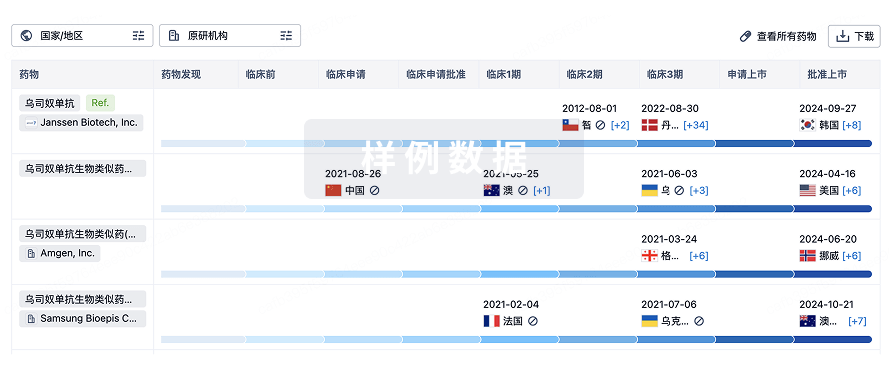预约演示
更新于:2025-12-13
MET-097
更新于:2025-12-13
概要
基本信息
原研机构 |
在研机构 |
非在研机构- |
最高研发阶段临床2期 |
首次获批日期- |
最高研发阶段(中国)- |
特殊审评- |
登录后查看时间轴
关联
5
项与 MET-097 相关的临床试验NCT06973720
A Phase 2b, Multi-Center, Randomized, Double-Blind, Placebo-Controlled Study to Investigate the Efficacy, Safety and Tolerability of Multiple Dose Regimens of Once-Weekly Switching to Once-Monthly MET097 in Participants With Obesity or Overweight (VESPER-3)
This study is designed to test the weight loss effects, safety, and tolerability of multiple monthly doses of MET097 after 12 weekly doses, compared to placebo. Participants are eligible if they have overweight or obesity and do not have type 2 diabetes.
开始日期2025-04-01 |
申办/合作机构 |
NCT06897202
A Phase 2b, Multi-Center, Randomized, Double-Blind, Placebo-Controlled Study to Evaluate the Efficacy and Safety of Once-Weekly MET097 in Adults With Obesity or Overweight, and Type 2 Diabetes Mellitus (VESPER-2)
This study is designed to test how well once-weekly MET097 (an ultra-long-acting GLP-1 receptor agonist) works to treat adults with obesity or overweight and type 2 diabetes mellitus (T2DM) compared to placebo. MET097 or placebo will be administered to individuals via subcutaneous injection once weekly for 28 weeks. If an individual is randomly assigned to MET097 they will receive one of four different dose regimens.
开始日期2025-03-14 |
申办/合作机构 |
NCT06924320
A Phase 1 Randomized, Double-Blind, Placebo Controlled. Single and Multiple Ascending Dose Study to Investigate the Safety, Tolerability, Pharmacokinetics, and Pharmacodynamics of MET233 Co-administered With MET097 in Adult Participants With Obesity or Overweight Including Participants With Type 2 Diabetes Mellitus
This study is designed to test how well the combination of MET233 with MET097 works to treat individuals with obesity or overweight with or without diabetes.
开始日期2025-03-03 |
申办/合作机构 |
100 项与 MET-097 相关的临床结果
登录后查看更多信息
100 项与 MET-097 相关的转化医学
登录后查看更多信息
100 项与 MET-097 相关的专利(医药)
登录后查看更多信息
151
项与 MET-097 相关的新闻(医药)2025-12-12
·游褒禅山
11月,海外top vc机构在创新药领域共发生17起投资事件,其中种子轮1起,A轮7起,B轮3起,C轮1起,D轮1起,战略投资3起,IPO事件1起;7起并购事件。
种子轮,Accipiter Biosciences,1200万美元。从头设计蛋白,开发双重激动剂
A+轮,MindImmune Therapeutics,1020万美元。开发抗体阻止一种外周固有免疫细胞(CD11c+细胞)进入大脑引起突触损伤,从而抑制与AD进展相关的神经炎症。
A+轮,T-Therapeutics,3200万美元。开发TCR-CD3新型TCE。
A轮,Bambusa Therapeutics,金额未披露。基于半衰期延长双特异性抗体技术平台,开发IL-4Rα / IL-31治疗特异性皮炎,IL-4Rα / IL-5治疗2型炎症性疾病如COPD
A轮,Quarry Thera,3200万美元。PROTAC先驱Craig Crews教授联合创办,新公司基于三种来自其实验室的诱导接近(induced proximity)新技术,研究尚未发表。
A轮,Dayra Therapeutics,2000万美元。由Versant Ventures孵化的口服大环肽公司,与biogen达成合作,首付款5000万美元
A轮,Braveheart,1.85亿美元。这是一家newco公司,25年9月恒瑞将心肌肌球蛋白(Myosin)选择性可逆抑制剂HRS-1893在大中华以外全球范围内开发、生产和商业化的独家权利有偿许可给Braveheart Bio。Braveheart Bio将向恒瑞支付6500万美元首付款(含3250万美元现金和等值3250万美元的Braveheart Bio公司股权)和完成技术转移后的1000万美元近期里程碑款,总计7500万美元,还有资格获得与临床开发和销售相关的里程碑付款,最高可达10.13亿美元。
A轮,Azalea Therapeutics,6500万美元。Jennifer Doudna领衔的体内CAR-T公司,Azalea 的双载体平台结合了靶向 T 细胞的 EDV(递送 Cas9 RNP 复合物)和携带无启动子 CAR 模板的人 T 细胞嗜性 AAV。
B+轮,Imbria Pharmaceuticals,金额未披露。核心管线产品Ninerafaxstat是一种新型心脏线粒体调节剂和部分脂肪酸氧化(pFOX)抑制剂,治疗nHCM患者
B轮,Gate Bioscience,6500万美元。开发创新分子门药物(Molecular Gate),通过在致病蛋白的源头(即细胞内)阻断它们来消除致病蛋白。
B轮,AAVantgarde Bio,1.41亿美元。该公司核心技术平台为“双杂交平台”(Dual Hybrid Platform),采用两种AAV载体,分别携带编码大型治疗性转基因的一半表达盒,该技术可在细胞核内将两个片段重组为完整的单一转基因,实现高效治疗蛋白表达。
C轮,Aspen Neuroscience,1.15亿美元。2018年成立,将患者自体皮肤成纤维细胞重编程为iPSC,然后将其分化为多巴胺能神经元前体细胞治疗帕金森。
D轮,Artios Pharma,1.15亿美元。Artios专注于DNA损伤修复(DDR)机制的靶向治疗,首条管线为ATR抑制剂,在不损害正常细胞的情况下,诱导癌细胞DNA损伤。第二条管线为Polθ抑制剂,用于DNA修复缺陷相关的实体瘤,尤其在BRCA突变的患者中展现出潜力。
IPO,Evommune,1.5亿美元。首发管线EVO756是MRGPRX2口服小分子拮抗剂,治疗慢性荨麻疹等;EVO301是一种IL18长效融合蛋白。
战略投资,Lifordi Immunotherapeutics,4200万美元,做自免的ADC。首发管线正在进行类风湿性关节炎(RA)1期研究,旨在评估LFD-200(将强效糖皮质激素直接递送至免疫细胞)。
战略投资,Solve Therapeutics,1.2亿美元。专有的CloakLink™技术旨在通过提高ADC的稳定性和降低ADC在各种药物与抗体比率下的疏水性来克服ADC通常面临的与有效载荷疏水性相关的限制。
战略投资,Iambic Therapeutics,1亿美元。AI制药明星公司,目前HER2共价抑制剂进入1期,CDK2/4和KIF18A处于临床前阶段
7起并购事件:
Halda Therapeutics,以30.5亿美元的价格被强生收购,Halda致力于推进其新型RIPTAC药物。
Repare Therapeutics,曾是合成致死领域的明星Biotech公司,已与非营利生物技术公司XenoTherapeutics, Inc.签订最终安排协议,后者将收购Repare所有已发行及流通普通股。2022年,罗氏以超13亿美元的总金额引进了Repare的选择性ATR口服小分子抑制剂Camonsertib。在2024年初,由于临床2期试验TAPISTRY研究完成了首例患者给药,Repare从罗氏获得了4000万美元的里程碑付款。但变数也随之而来,罗氏在付完4000万美元的十多天后,便毫无征兆的宣布将退回Camonsertib的全部权益。
Cidara Therapeutics,被默沙东以92亿美元现金收购,将其处于3期临床试验的主要资产流感预防药物CD388收入囊中。
Mersana Therapeutics,被Day One Biopharmaceuticals以2.85亿美元收购。曾经作为ADC的明星公司,与GSK、Merck KGaA、J&J等MNC达成多项合作。但近年的几项临床失败导致其逐渐陷入困境,XMT-1522(HER2-ADC)因出现1例与药物相关的患者死亡事件,被FDA暂停临床研究,最终导致开发终止,股价也是一落千丈。
Metsera,被辉瑞近百亿美金收购,做长效GLP-1和Amylin。
SixPeaks Bio,由Versant Ventures创立,被阿斯利康3亿美金左右收购,做减脂增肌的ActRII单抗
(以下正文不做海外新闻稿翻译工,观察融资事件中值得长期关注的公司,在此进行整理与研究)
本期值得关注的有9家公司
1. Imbria
【融资事件】B轮,6500万美元左右
2025年11月,AXA IM Alts参与了Imbria一轮规模扩大的B轮融资。
Imbria创立于2018年,总部位于美国波士顿。
2025年4月,Imbria完成5750万美元的B轮融资,由新投资者Deep Track Capital领投,参与融资的其他新投资者包括AN Ventures、Catalio和Cytokinetics,老投资者RA Capital 和SV Health investors也参与了融资。
【核心技术】靶向心肌细胞能量代谢
Ninerafaxstat是一种治疗心脏疾病的创新疗法,其特征是心脏能量供需失衡。为了维持正常的收缩功能,心脏需要大量的能量,这些能量主要由线粒体以ATP的形式产生。心脏通常使用两种主要燃料来产生能量:脂肪酸和葡萄糖。
Ninerafaxstat是一种部分脂肪酸氧化(pFOX)抑制剂,其作用是将心脏的偏好从脂肪酸转向葡萄糖。代谢的这种转变导致更有效的线粒体能量产生,有可能改善休息和运动时的心脏功能。
【核心管线】
非梗阻性肥厚型心肌病 (nHCM) 是一种遗传性心脏病,当心肌异常增厚时就会发生,从而损害心脏正常充盈和有效泵血以满足身体代谢需求的能力。 nHCM 拥有数十万确诊或潜在的患者群体,且缺乏有效疗法。
临床进展:
针对非肥厚型心肌病(nHCM)和射血分数保留型心力衰竭(HFpEF)的2a期临床试验已完成。在1期和2期临床试验中,ninerafaxstat 显示出良好的安全性和耐受性。
目前正在进行 FORTITUDE-HCM ( NCT07023614 ),这是一项 2b 期全球随机双盲安慰剂对照临床试验,旨在评估在有症状的 nHCM 患者标准治疗的基础上,nierafaxstat 与安慰剂相比的疗效和安全性。
目前也正在筹划启动针对 HFpEF 的 2b 期临床试验,这是一个巨大且日益增长的未满足需求。
2. GATEBIO
【融资事件】B轮,6500万美元左右
B轮融资由新投资者Forbion领投,其他新投资者礼来以及现有投资者Versant 、Andreessen Horowith、GV和ARCH跟投。
公司历史事件:Gate Bioscience成立于2021年。2023年11月结束隐匿运营,宣布获得由Versant Ventures和a16z Bio+Health领投的6000万美元A轮融资,ARCH Venture Partners和GV参与跟投。2025年7月,与礼来达成合作,根据协议条款,Gate将获得预付款和股权投资,并有资格在实现某些开发、监管和商业里程碑后获得里程碑付款,以及全球净销售额的分层特许权使用费,交易总价值高达8.56亿美元。
公司CEO和联合创始人Jordi Mata-Fink在创立Gate之前,曾在Flagship 工作,参与创立并推出了多家生物技术公司,包括Editas 、Rubius 和Generate。Pat Sharp是Gate公司的科学联合创始人兼研究副总裁。他率先证明小分子可以通过分泌转位子中的Sec61选择性地抑制蛋白质分泌。加入Gate之前,帕特曾在默克公司担任药物化学家。
【核心技术】分子门控:选择性阻止致病蛋白分泌到胞外
人体产生超过4000种不同的细胞外蛋白,超过1000种细胞外蛋白与疾病相关。与其他蛋白质一样,细胞外蛋白在细胞质中翻译,然后必须穿过细胞膜才能从细胞内部转移到细胞外部。它们通过内质网中的一个通道——分泌转位子(secretory translocon)完成这一过程。分子门控系统能够识别致病蛋白的特定氨基酸序列,并选择性地阻断其通过通道的进程。由于无处可去,该蛋白最终会被细胞降解,从而被清除。在真核细胞中,转位子的核心是由三个亚基组成的复合物,称为 Sec61 复合物,在内质网(ER)膜上形成通道,对蛋白质进入内质网至关重要。
【笔记】挺有意思的概念,核心就是如何控制底物的选择性了,否则会有广泛毒性。公司官网还没有披露具体分子机制和管线。通过查找科学联合创始人Pat Sharp的文献,论文详细阐述了小分子抑制剂如何通过结合在 Sec61上,利用不同蛋白质信号肽的序列差异,实现选择性拦截。当核糖体带着新蛋白来到门口时,小分子会与该蛋白的特定信号肽序列发生相互作用,具有底物选择性。目前还是一个非常概念的平台技术,期待公司后续管线数据。
3. Lifordi immunotherapeutics
【融资事件】战略融资,4000万美元左右
Lifordi获得赛诺菲创投的战略投资,以及来自现有投资者 ARCH Ventures、5AM Ventures 和 Atlas Venture 的资金,用于支持正在进行的 LFD-200 一期临床试验,并用于 CMC 准备工作,以确保二期临床试验的药物供应。Lifordi成立于2023年,由ARCH、5AM、Atlas联合孵化,A轮获得7千万美元融资。公司曾荣获Endpoints News颁发的2024“生物医药最具潜力新锐”。 公司的总裁兼首席执行官是5AM Ventures 的风险合伙人Arthur O. Tzianabos 博士。
【核心技术】自免ADC:靶向VISTA,递送糖皮质激素
传统的口服激素(如泼尼松)虽然抗炎效果好,但全身副作用巨大(骨质疏松、代谢紊乱等)。Lifordi 的基于抗体偶联药物 (ADC) 的递送平台靶向一种主要表达于免疫细胞(包括髓系细胞和淋巴系细胞)表面的蛋白VISTA。通过VISTA抗体精准靶向免疫细胞,将激素直接“送进”致病细胞内部释放。
VISTA 独特的生物学特性,例如其快速内化和细胞内积累,使其成为 ADC 疗法的理想选择。Lifordi 的主要 ADC 候选药物 LFD-200 的临床前研究表明,该药物具有血清半衰期短、免疫细胞内停留时间长以及能够在这些细胞内长期发挥免疫抑制功能,且不会产生全身给药相关的毒性。
LFD-200已经入I 期临床试验,目前正在招募健康受试者并进行给药。Lifordi 近期在美国风湿病学会 (ACR) 2025 年会上公布了非临床数据,数据显示,每 7 天皮下注射一次临床相关剂量的 LFD-200,持续 13 周,可在免疫细胞中维持糖皮质激素暴露,且未观察到全身毒性。
【笔记】其他公司布局ADC自免药物的有:
艾伯维:曾致力于开发TNFα抗体偶联激素,但临床进展并不顺利
恒瑞医药:2024年4月7日,恒瑞CD40 ADC专利公开。
映恩生物:2024年4月7日,同一天,映恩BDCA2 ADC专利公开主打管线DB-2304靶向BDCA2,已经进入了临床I期阶段。
4. azalea therapeutics
【融资事件】种子轮及A轮,8200万美元
11月4日,Azalea Therapeutics宣布正式成立,并完成由 Third Rock Ventures 领投的种子轮和A轮融资,总额达8200万美元,RA Capital Management、Yosemite、Sozo Ventures 和部分个人投资者也参与了投资。
Azalea目前设立于加州大学伯克利分校,其核心技术源于两项顶尖学术合作:诺贝尔奖得主Jennifer Doudna在创新基因组研究所开展的研究,以及Justin Eyquem博士在加州大学旧金山分校进行的科研工作。
【核心技术】双载体体内CAR-T
Azalea 公司的核心资产是其新型递送技术平台—Azalea 的双载体平台结合了靶向 T 细胞的 EDV(递送 Cas9 RNP 复合物)和携带无启动子 CAR 模板的人 T 细胞嗜性 AAV。
通过将突变型水疱性口炎病毒糖蛋白(VSVGmut)与抗体来源的单链可变片段(scFv)配对展示在包膜递送载体(EDV),用来包装 Cas9 核糖核蛋白复合物(Cas9 RNP),构建了 Cas9-EDV。该研究所述的包膜递送载体(EDV)利用逆转录病毒的类病毒颗粒(VLP)组装来实现对 Cas9 RNP 的瞬时递送。
该技术与高效的T细胞嗜性AAV相结合,递送无启动子的同源重组修复模板,从而能够在T细胞内的特定基因组位点进行可编程的、位点特异性的大片段基因插入。这种双载体平台通过在天然启动子的调控下实现细胞和基因组位点特异性的基因插入,提供了多层精准性,并有望提高治疗的持久性、疗效和安全性。
示意图展示了靶向分子(蓝色)和VSVGmut(橙色)位于Cas9-EDV外表面的scFv。Cas9-EDV包装预先形成的Cas9-sgRNA复合物,以避免将基因编辑基因编码到病毒基因组内。
【笔记】Jennifer Doudna真的很喜欢做双载体基因插入...Intellia以前的第三条管线NTLA-3001管线就是利用LNP和AAV做AATD适应症的体内基因插入,2024年7月在英国获批临床,但2025年1月公司启动战略调整,把重心都放在了前两条管线上,停止了NTLA-3001的开发。但这个双载体策略笔者一直都不太看好,成本高,而且两个载体递送到体内太复杂了。
5. Evommune
【融资事件】IPO
11月7日,自免疾病开发Biotech Evommune登陆美股市场,公司募资1.5亿美元。
【核心管线】MRGPRX2
MRGPRX2 是 GPCR家族成员,主要表达于肥大细胞表面,其激活机制与经典 IgE 介导的过敏反应不同 ,属于“非经典激活”通路。该受体可被多种内源性(如神经肽、抗菌肽)和外源性(如药物、化学刺激物)配体激活,触发肥大细胞脱颗粒,释放组胺、蛋白酶等炎症介质,导致伪过敏反应、慢性炎症及瘙痒等症状。
2 期研究显示,300mg 每日一次或 50mg 每日两次给药 4 周后,总体改善率达 93%,瘙痒评分(Pruritus NRS)较基线下降约 50%,高低 IgE 人群均有效。
【笔记】目前尚无MRGPRX2口服小分子药物获批上市,竞争态势还比较好,但各大药企的加入使其研发火热起来。但目前该靶点尚无药物获批上市,靶点成药性仍待验证。
该靶点相关交易:
2025年3月3日,诺华以8.3亿美元的总价引进了Kyorin的KRP-M223,KRP-M223目前处于临床前状态。
Escient曾经开发过一款MRGPRX2 拮抗剂EP262(INCB000262),曾开展慢性荨麻疹和特应性皮炎的 II 期临床试验,但因体内毒理学数据问题,后续公司的收购方Incyte于 2024 年暂停中期试验招募。
6. Sixpeaks Bio
【并购事件】
2022年,SixPeaks由Versant创立。该公司源自 Versant Ventures 位于巴塞尔科技园的 Ridgeline Discovery Engine 孵化器。
2024年5月23日,公司走出隐匿模式,并宣布完成由创始投资者Versant Ventures领投的3000万美元A轮融资。并与阿斯利康达成战略合作,后者将在未来两年提供包括预付款和短期付款在内的最高8000万美元的额外非稀释性融资,以获得在公司为其主导抗体提交IND申请时以预定价格收购SixPeaks的选择权。
2025年,阿斯利康行使期权,拟以最高3亿美元的价格收购SixPeaks。该交易包括 1.7 亿美元的预付款、两年内支付的 3000 万美元的额外固定付款,以及根据某些监管里程碑的实现情况而支付的 1 亿美元。
【核心管线】ActRII抗体/ActRII抗体偶联GLP-1多肽
激活素Ⅱ型受体(Activin type Ⅱ Receptor,即ActRⅡ)是转化生长因子β(TGF-β)受体家族的成员,是包括活化素A(Activin A)和活化素B(Activin B)及BMP7、BMP9、BMP10、GDF1、GDF8(myostatin)、 GDF11和Nodal在内的其他TGF-β家族成员的II型受体。
ActRⅡ存在于脂肪和肌肉细胞中。在脂肪细胞中,激活素通过ActRⅡ进行脂质存储,这是肥胖的重要驱动因素,阻断该信号通路,则可促进脂肪代谢;在肌肉细胞中,ActRⅡ受体传导的信号通路能够抑制肌肉生长并导致其萎缩,阻断骨骼肌中的激活素信号可以抑制这种萎缩,并可以促进肌肉质量的增加,帮助肥胖患者在减肥的同时改善身体成分和代谢。
【笔记】
1. 减脂不减肌热潮:尽管GLP-1药物在减重上效果十分突出,但减去的体重中有近25%-39%含量的肌肉,而肌肉质量下降的危害十分巨大。
目前活跃的研发方向涵盖激活素受体ACVR、肌肉生长抑素MSTN、抑制素亚基βE(INHBE)、Apelin受体APJ、甲状腺激素受体β(THRβ)、选择性雄激素受体调节剂(SARM)、瘦素leptin、黑色素受体MC4R、GDF15及Ghrelin受体等关键靶点。部分单靶点药物或GLP-1多靶点联合方案已进入I-III期临床试验阶段。
其中ActRII单抗进度最快的是礼来的bimagrumab,该药是2023年7月礼来以19.25亿美元收购Versanis获得的。在此之前,ActRII靶点已在地中海贫血和肺动脉高压上验证成药性。2025年6月礼来在ADA会议上公布了Bimagrumab治疗减重的2b期临床数据,临床数据炸裂,ActRII靶点迎来POC:治疗72周,Bimagrumab治疗组减重10.8%,但脂肪占比100%,肌肉不丢反而增加2.5%;司美格鲁肽治疗组减重15.7%,只有71.5%来自于脂肪,肌肉损失7.4%;联合治疗组减重22.1%,92.9%来自于脂肪,肌肉只损失2.9%。该靶点国内进度最快的是来凯医药。
2. Versant Ventures的先建后买模式: Versant是“Option-to-Acquire”模式的先驱之一。简单来讲,Versant在孵化一家公司时,会直接找一家大药企谈合作,药企提供部分研发资金,作为交换,药企获得在未来某个时间点以预定价格直接收购这家公司的权利。SixPeaks也是该模式下的产物。
7. Metsera
【并购事件】
辉瑞已完成对Metsera所有已发行普通股的收购,以每股65.60美元现金支付,企业价值约为70亿美元。花旗集团担任辉瑞公司此次交易的财务顾问,Wachtell, Lipton, Rosen & Katz 律师事务所担任其法律顾问。
【核心管线】
MET-097i,一种每周和每月注射一次的 GLP-1 受体激动剂 ,即将开始 3 期临床
MET-233i,一种每月注射一次的胰淀素类似物候选药物,目前正在 1 期临床中评估其作为单药疗法以及与 MET-097i 联合用药的疗效
一种处于 1 期临床试验阶段的口服 GLP-1 RA 候选药物
以及其他临床前营养刺激激素疗法。
【笔记】辉瑞和诺和诺德的抢购以辉瑞胜利落下帷幕,交易金额也成为今年top10的并购案例。Amylin药物的持续突破吸引了更多MNC重金入场,2025年6月,礼来和诺和诺德在ADA会上公布最新数据;2025年3月,艾伯维与罗氏在短短十天内,相继宣布重磅交易,强势进军Amylin赛道。
8. Cidara
【并购事件】
11月14日,默沙东宣布以92亿美元收购Cidara Therapeutics,该交易预计将于2026年第一季度完成。截至11月13日收盘市值为33亿美元
【核心技术】
Cidara公司专有的Cloudbreak™药物-Fc偶联物(DFC)技术平台的核心设计理念是将高效的小分子药物与经过工程改造的人源抗体Fc片段稳定地结合成一个单一分子,旨在细胞外环境发挥长效作用。
【核心管线】流感长效预防药物
CD388将成熟的抗病毒小分子药物扎那米韦(zanamivir)与人体抗体Fc片段偶联 。分子靶向部分采用了新颖的扎那米韦二聚体,两个扎那米韦分子通过一个稳定的15原子中心连接子相连。其效应部分则是一个经过工程改造的人源IgG1 Fc片段,该片段包含YTE三重突变(M252Y/S254T/T256E),用以显著延长药物在体内的半衰期。多个扎那米韦二聚体通过柔性连接子共价连接到Fc片段表面,平均每个Fc分子偶联约4.5个二聚体。
这种设计带来了两大核心优势:广谱强效:多价的扎那米韦使其对流感病毒的抑制活性显著增强,且对包括奥司他韦(达菲)耐药株在内的所有测试毒株均有效。超长半衰期:Fc片段的引入,使得CD388的半衰期延长至6-8周,理论上单次给药即可提供覆盖整个流感季节的保护。CD388旨在解决现有流感疫苗有效率不高(通常约40%),且在老年人和免疫功能低下人群中效果不佳的巨大未满足需求。
CD388的作用机制是通过高效抑制流感病毒表面的神经氨酸酶(NA)来实现的。NA是病毒生命周期中的关键酶,负责切断新复制的病毒颗粒与宿主细胞的连接,使其得以释放并感染新细胞。CD388的多价设计利用了“亲合力效应”,一个分子能够同时桥接单个或不同病毒颗粒上的多个NA活性位点,从而形成病毒聚集体,在空间上阻碍病毒传播,这就是为什么其在细胞水平的活性为何远高于单体扎那米韦。选择NA作为靶点是实现“通用性”预防的核心策略,因为NA的活性位点在所有已知的甲型和乙型流感病毒株中高度保守,且基因突变速率慢于血凝素(HA),使CD388不易因病毒的季节性变异而失效。此外,CD388与疫苗的作用机制不同且互补:疫苗主要诱导抗体阻止病毒进入细胞,而CD388则抑制病毒从被感染细胞中释放,理论上可产生协同保护效果,且临床前数据证实二者可联合使用。
2b期临床是一项大规模(N=5,041)、随机、双盲、安慰剂对照研究,在18-64岁的健康、未接种疫苗的成年人中进行,评估了单次皮下注射三种不同剂量(150 mg, 300 mg, 450 mg)CD388的预防效果。研究的主要终点是预防实验室确诊、伴有发热(≥38.0°C)及呼吸道/全身症状的流感样疾病(ILI)。2b期临床试验结果显示研究在所有三个剂量组中均成功达到主要终点,显示出清晰的剂量-反应关系,其中,450 mg剂量组的预防效力(PE)高达76.1%(95% CI: 49.3, 89.9; p < 0.0001),300 mg组为61.3%(p=0.0050),150 mg组为57.7%(p=0.0024)
【笔记】去年罗氏的玛巴洛沙韦以仅需一次性用药的优势开始撼动奥司他韦多年的地位,今年抗流感用药市场迎来国产元年,目前已经批准了3款跟玛巴洛沙韦机制类似的国产原研药。但是流感治疗仍然面临保护效力低(疫苗)和仅早期使用有效(治疗用药)的问题。CD388的非免疫依赖性作用机制、季节性长效保护、广谱覆盖、高保护效力及卓越安全性让其拥有了差异化的特性。总体来看,CD388是开拓了一个不同的市场,为疫苗保护不足的高风险人群(老年人、免疫功能低下者)提供关键保护,和现有的治疗药物和传统疫苗没有直接竞争关系,更多的是互补关系。
近年来,为应对K药2028年的专利到期,默沙东积极进行并购动作,此次收购是默沙东今年第二笔百亿美元级的重磅交易。
9. HALDA
【并购事件】
强生将以30.5亿美元的价格收购Halda。Halda刚在10月份公布其首个管线HLD-0915的一期临床数据。Halda Therapeutics成立于2019年,创始人是耶鲁大学教授 Craig Crews,发明了蛋白水解靶向嵌合体(PROTACs)并成立了 Arvinas。
【核心技术】RIPTAC
RIPTAC,全称为“调控诱导邻近靶向嵌合体”,是继PROTAC之后新兴的诱导邻近疗法。RIPTAC是一种双功能小分子,一端结合肿瘤细胞中特异性表达的靶蛋白(TP),另一端结合对细胞生存至关重要的泛必需效应蛋白(EP)。当这两种蛋白在肿瘤细胞内被RIPTAC连接时,会形成稳定的三元复合物,导致EP功能丧失,从而诱导癌细胞凋亡。
与传统靶向疗法不同,RIPTAC不需要抑制靶蛋白的活性,只需肿瘤细胞中靶蛋白的表达量高于正常细胞即可发挥作用。由于正常细胞中缺乏高表达的靶蛋白,因此不易受到RIPTAC的影响,这理论上赋予了该策略更高的肿瘤选择性和更宽的治疗窗口。
与基于事件驱动(单一分子能催化目标蛋白的多个拷贝)的PROTAC不同,RIPTAC则基于占据驱动,即,一次只抑制一份蛋白质拷贝。但目前的结果发现,RIPTAC并不需要高剂量,而是只需要结合足够的必需蛋白质就能触发细胞杀伤效应。
【核心管线】治疗mCRPC
HLD-0915可同时结合两种蛋白质:雄激素受体(AR),从而选择性地将RIPTAC疗法靶向肿瘤细胞;以及一种重要的细胞蛋白——溴结构域4(BRD4),该蛋白参与转录调控。由此形成的三聚体复合物可抑制BRD4的功能,并选择性地诱导前列腺癌细胞死亡。
Halda公司公布了HLD-0915在转移性去势抵抗性前列腺癌(mCRPC)患者中的初步I期临床数据,证实了其安全性、药代动力学和疗效。首次人体试验结果表明,HLD-0915耐受性良好,并显示出令人鼓舞的初步抗肿瘤活性,包括降低PSA和ctDNA水平,以及根据RECIST标准评估的部分缓解。这些患者均为既往接受过多种治疗方案后病情进展的晚期前列腺癌患者。所有剂量组均观察到抗肿瘤活性,且该活性也存在于具有不良分子特征的患者中。HLD-0915已获得FDA快速通道资格认定。
【笔记】此次收购是强生今年第二笔重磅交易。今年1月强生以约146亿美元收购CNS领域的Intra-Cellular Therapies。
·END·
免疫疗法细胞疗法并购引进/卖出
2025-12-11
·星际微光
辉瑞继收购Metsera后,再次加码肥胖药物管线,与中国药友制药达成一项总额达19亿美元的许可协议,获取在研GLP-1受体激动剂YPO5002。该药目前处于一期临床阶段,辉瑞将承担后续开发与商业化。
此前辉瑞因肝毒性终止了danuglipron开发,肥胖管线告急;此次交易有望丰富其产品组合,并与现有的PF-07976016形成组合疗法。
Metsera的收购虽经历与诺和诺德的激烈竞购,但也为辉瑞带来多个先进候选药物,预计2028年上市。该系列动作显示辉瑞正全力押注肥胖治疗市场。
有问题,问星光智能体!
人类基地:逃离!这可能是继AI之后,影响世界权力结构的最大技术实验
投资亮点
一、全球肥胖治疗蓝海市场,GLP-1 为核心增长引擎
GLP-1类药物(如司美格鲁肽、替尔泊肽)已被证实对减重和代谢疾病治疗效果显著,是近十年增长最快的药物品类之一。
全球GLP-1市场规模预计在2030年前突破1500亿美元。辉瑞押注GLP-1战略明确,有望抢占被诺和诺德、礼来主导的市场份额。
YPO5002虽仍处早期,但为口服非肽类GLP-1激动剂,若结构类似于礼来的orforglipron(即将申请FDA批准),则市场前景巨大。
二、以“轻资本”模式布局早期创新资产,风险可控
辉瑞仅支付1.5亿美元首付款,大部分交易价值与未来的开发和商业化成果挂钩,是一种“里程碑式支付结构”,可有效控制前期风险。
相比Metsera 100亿美元“重资产”收购,此举为典型的风险对冲与成本优化投资策略。
三、多资产并进,建立组合疗法潜力
辉瑞已明确将YPO5002与其仅存的在研GLP-1资产PF-07976016(II期)联合开发,意图打造组合治疗策略,在疗效、耐受性或靶向人群上形成差异化。
若开发成功,可能形成“类GLP-1 + GIP/Amylin”联合方案,复制礼来Mounjaro的成功路径。
四、Metsera交易后续增强,打造GLP-1创新平台
Metsera收购为辉瑞带来MET-097i(长效GLP-1)、MET-233i(胰淀素类似物)及两款口服GLP-1候选药物,形成从口服到注射的全产品线布局。
此次药友交易进一步丰富产品组合,是Metsera收购后的战略延伸,表现出辉瑞对肥胖治疗领域的中长期持续押注。
五、中国创新药国际化的成功案例,对药友/复星意义重大
药友制药是复星医药子公司,YPO5002被全球药企巨头辉瑞选中并推进开发,标志着其创新研发能力获得国际认可。
这不仅带来直接经济收益(首付款+潜在里程碑),也大幅提升其品牌国际影响力与未来出海机会。
药友的价值分析
一、产品优势
1、聚焦五大治疗领域:包括肝病、心血管疾病、营养支持、抗感染及中枢神经系统(CNS),均为临床需求大、市场前景广阔的领域。
2、已有两款全球首创(First-in-the-world)创新药物,显示公司具备强原创能力,而不仅仅是仿制药或改良型药物。
3、管线中包括GLP-1受体激动剂YPO5002,已获得辉瑞1.9亿美元合作,进一步验证其产品在全球市场的竞争力。
二、技术优势
1、拥有四大创新技术平台(官网未具体列出,推测涵盖小分子、多肽、口服剂型优化等方向)。
2、公司在高端制剂开发、高活性药物处理、温敏/缓释技术等方面具备自主研发能力。
3、持续投入:每年将5%销售收入投入研发,配备超200人的高素质研发团队,成员均具有高等教育背景。
三、平台优势
1、已建立国际GMP合规的生产体系,可满足全球药政合规要求,有助于推动产品出口及国际授权。
2、拥有从研发—临床—生产—注册—商业化的完整闭环能力,可支持从0到1的原创新药开发。
3、与多国合作,拥有国际临床试验执行能力,YPO5002正在澳大利亚开展I期临床。
四、服务优势
1、公司长期与全球大型制药企业开展合作,如此次与辉瑞的交易,显示出其具备国际BD能力与可靠合作声誉。
2、能够提供灵活的许可、技术转移、合同开发生产(CDMO)等服务模式,适配不同客户需求。
五、商业模式
1、药友采用“双轮驱动”模式:自主研发创新药+ 引进全球先进产品并本土化运营。
2、国际化BD能力突出,既可输出创新资产(如YPO5002),也可引进海外优质产品在中国落地。
3、与母公司复星医药协同,获得资本、资源与政策支持。
六、医疗价值
1、重点布局“未被满足的临床需求”领域,如非酒精性脂肪肝、肥胖、抗感染等,精准对接全球慢病与老龄化趋势。
2、YPO5002聚焦肥胖与代谢疾病领域,有望在健康中国2030战略下提供长期人口健康解决方案。
3、未来产品若进入医保或形成广泛合作,有望显著降低治疗负担并提高患者可及性。
七、未来前景
1、在全球GLP-1药物产业链热潮中,药友已成功获得国际巨头(辉瑞)认可,是其国际化战略的重要突破。
2、随着YPO5002等产品临床推进,若取得良好数据,公司将具备更强议价能力与融资吸引力。
3、依托复星全球布局,有望成为“出海型中国创新药企业”代表之一,在国际市场建立自有品牌影响力。
药友的综合能力
一、核心能力概览
药友制药当前强调的核心能力包括以下几个关键维度:
能力类别
关键内容
研发能力
年销售额5%投入研发;200+人研发团队;4大创新平台;拥有2项全球首创新药
制造能力
高科技制造设施;符合国际GMP标准
质量体系
国际质量标准认证;支持全球市场合规
治疗领域聚焦
肝病、心血管、营养支持、抗感染、中枢神经系统(CNS)
二、研发能力(Innovative R&D)
1、投入与团队建设:5%的年销售收入用于研发,在中国仿制药为主的企业中属于偏高水平,表明其创新导向。
拥有200多人的研发团队,具备高学历背景,为支持创新和一致性评价项目打下人才基础。
2、创新平台(4个)
结合产业逻辑,推测其可能涵盖以下领域:小分子药物创新与仿制平台,复杂制剂开发平台(如缓释、口服干乳剂、注射乳剂等),新型给药系统(NDDS)平台,中枢/代谢类药物靶点平台(如GLP-1等)
3、创新成果
已拥有2项全球首创药物,说明药友不仅仅是仿制药制造商,具备First-in-class / Best-in-class潜力。
三、高科技制造能力(High-tech Manufacturing)
药友强调其拥有高科技制造能力,这对生物制药企业至关重要,特点包括:
1、建有多个GMP认证生产车间,涵盖小分子化学合成、制剂生产与冻干线;
2、可能涉及高度复杂工艺(如高活性药物生产、冻干乳剂、缓控释);
3、支持全球多区域注册标准,有助于国际客户CDMO合作或自有产品出海。
四、国际GMP合规性(International GMP Compliance)
药友制药具备国际质量管理体系认证能力,根据其市场表现推测,可能包括:
1、中国NMPA认证;
2、欧盟CEP或EDQM认证;
3、美国FDA cGMP体系对接能力;
这为其产品出口欧美、开展国际BD、开展CDMO/CMO服务奠定基础。
五、治疗领域专注与能力整合
药友将研发与制造重点聚焦在五大治疗领域:
1、肝病:包括谷胱甘肽等肝脏保护产品;
2、心血管系统:如美托洛尔等慢病药物;
3、营养代谢:如阿法骨化醇;
4、抗感染:涵盖多种基础广谱抗菌药;
5、中枢神经系统(CNS):如度洛西汀、文拉法辛等抗抑郁药。
这种聚焦使其能够积累专业深度,也符合全球疾病谱变化趋势。
六、全球化能力与平台价值
药友不仅具备出口注册能力,还正逐步搭建其国际合作平台:
1、与辉瑞达成高达19亿美元的GLP-1合作,标志其产品与平台获得国际顶级药企背书;
2、有能力为跨国药企提供临床前开发、临床药品生产等服务;
3、凭借其“制剂+原料药一体化能力”,具备极高的CDMO商业化转化潜力。
药友的产品线
一、产品类型与适应症概览
药友制药当前的产品主要包括制剂产品(Finished Dosage Forms)和原料药(APIs),面向国内外市场,现列出部分核心品种及其用途:
1、还原型谷胱甘肽注射剂
适应症:肝炎患者肝脏保护、化疗过程中的毒性防护
技术特点:广泛应用于肝病与抗肿瘤支持治疗
市场潜力:在中国及发展中国家有较大市场需求,在欧美可进入抗氧化及辅助治疗市场
2、前列地尔干乳剂注射剂(Alprostadil Dried Emulsion)
适应症:血管扩张、微循环改善,常用于心血管疾病
技术特点:采用冻干乳剂这一独特制剂形式,便于储存与使用
创新性:制剂工艺有显著差异化,可能具备专利保护,提升出海竞争力
3、还原型谷胱甘肽片
适应症:抗氧化、肝脏保护
市场定位:适合肝病慢性管理及保健用途
发展趋势:在营养补充剂/功能性食品市场也具跨界潜力
4、阿法骨化醇片(Alfacalcidol)
适应症:骨质疏松、维生素D代谢障碍
市场价值:针对老年人群,符合老龄化趋势,适合长期慢病管理
5、文拉法辛(Venlafaxine)& 度洛西汀(Duloxetine)
适应症:重度抑郁障碍(MDD)、广泛性焦虑障碍(GAD)
意义:涉及中枢神经系统用药(CNS),为高增长精神类疾病市场核心品种
国际化空间:如具备一致性评价或欧美注册资质,可进入仿制药替代市场
6、美托洛尔缓释片(Metoprolol Succinate ER)
适应症:高血压、心绞痛、心力衰竭
用药基础大:全球处方量极大,为基础心血管治疗药物之一
缓释制剂技术要求高:若具备BE数据或可实现出口,将具有较强竞争力
二、技术优势分析
公司产品多涉及冻干、缓释、干乳剂等复杂制剂技术,具备明显技术壁垒;
具备大批量GMP生产能力,覆盖注射剂、片剂、胶囊等剂型,适应国际市场注册要求;
产品中部分为创新剂型或稀缺仿制药品种,如Alprostadil干乳剂形式较为少见。
三、市场定位与全球潜力
产品类别
国内市场机会
国际市场潜力
抗氧化/保肝类(谷胱甘肽)
肝病高发、化疗支持
可进入补充剂、辅助治疗领域
心血管类
高血压人群庞大、基础用药
若满足FDA/EMA标准,适合出口替代
CNS类(抗抑郁)
精神健康重视度上升
在欧美为主流治疗药物,仿制空间大
营养内分泌(阿法骨化醇)
老龄化推动长期使用
适合进入发展中国家医保体系
四、产品组合特征与战略方向
1、产品涵盖慢病管理、支持治疗、精神健康及心脑血管多个关键治疗领域;
2、构建“大处方量药物+ 差异化复杂制剂+ 创新候选物(如YPO5002)”的产品梯队;
3、可通过“原料药+ 制剂一体化”出口模式增强供应链控制力;
4、具备从仿制药向创新仿制药、改良新药、创新药逐步过渡的产品战略逻辑。
欲深入了解更多行业洞察,请扫以下二维码加入社群:
公司已完成项目
星际微光已完成的项目(截至2023.9,仍在继续......)
圆满中秋 | 星际微光七年完成100个咨询项目
咨询、调研、PR、投资、融资、营销、技术转化项目需求请扫码联系我们:
点击“阅读原文”,看看:可能影响世界权力结构的最大技术实验
并购申请上市
2025-12-10
Medical & Beauty
内容导读
近年来,GLP-1药物无疑是全球医药市场最耀眼的明星。它以卓越的降糖减重效果,点燃了万亿级的市场想象空间,也引发了一场前所未有的“军备竞赛”。从国内药企的奋力追赶,到跨国巨头的深度布局,这条赛道已进入群雄逐鹿的白热化阶段。
今天,我们就来系统盘点一下19家在GLP-1领域崭露头角的企业。
编辑 / 减脂行业前沿 内容组
01
已获批上市,抢占市场先机
1、华东医药——利拉鲁肽注射液(商品名:利鲁平)
公司介绍:国内领先的综合性制药企业,在内分泌、自身免疫等领域深耕多年,商业化能力强大。
产品介绍:利鲁平是华东医药自主研发的利拉鲁肽生物类似药,原研为诺和诺德的诺和力®。
上市时间:2023年3月。
获批时间:2023年3月28日,获批用于成人2型糖尿病,成为国内首个获批的利拉鲁肽生物类似药。
【产品获批适应证】适用于治疗成人2型糖尿病。
2、仁会医药——贝那鲁肽注射液(商品名:菲塑美)
公司介绍:专注于创新生物药研发的中国本土企业,菲塑美是其核心产品。
产品介绍:菲塑美是全球首个且唯一的全人源GLP-1类药物,具有更高的氨基酸同源性和更低的免疫原性风险。
上市时间:2023年7月27日。
获批时间:2023年7月25日,正式获批用于肥胖或超重适应症,是国内首款获批减重适应症的GLP-1原生新药。
【产品获批适应证】适用于成年BMI≥28kg/m²(肥胖),或BMI≥24kg/m²(超重)伴至少一种体重相关合并症(如高血糖、高血压、血脂异常、非酒精性脂肪肝等)的成人患者。
3、通化东宝——利拉鲁肽注射液
公司介绍:国内胰岛素领域的传统巨头,正积极向GLP-1等新型降糖药领域拓展。
产品介绍:利拉鲁肽生物类似药,上市申请已获受理。
上市时间:2023年12月4日。
获批时间:2023年11月28日,正式获得中国国家药监局(NMPA)批准,适应症为2型糖尿病。
4、诺和诺德——司美格鲁肽注射液(商品名:诺和盈®)
公司介绍:全球糖尿病护理领域的绝对领导者,GLP-1药物的开拓者和引领者。
产品介绍:诺和盈®是原研司美格鲁肽的减重适应症商品名,其降糖版诺和泰®早已在中国上市。
上市时间:2024年11月17日上市。
获批时间:2024年6月18日,正式获得中国国家药监局(NMPA)批准,用于长期体重管理。
【产品获批适应证】用于初始BMI≥30kg/m²(肥胖),或≥27kg/m²(超重)且存在至少一种体重相关合并症(如高血糖、高血压、血脂异常、阻塞性睡眠呼吸暂停或心血管疾病等)的成人患者,作为低热量饮食和增加体力活动的辅助治疗。
5、翰宇药业——利拉鲁肽注射液
公司介绍:国内多肽药物领域的龙头企业之一,拥有“原料药+制剂”一体化优势。
产品介绍:公司自主研发的利拉鲁肽生物类似药,主要面向国际市场。
上市时间:2024年12月23日。
获批时间:2024年12月25日,获得美国FDA批准上市,成为美国首款获批的利拉鲁肽生物类似药。
6、信达生物——玛仕度肽
公司介绍:信达生物是一家集研发、生产与商业化能力于一体的综合性生物制药公司。致力于成为覆盖肿瘤、代谢性疾病、自身免疫、眼科等重大疾病领域的“全能型生物制药企业”。
产品介绍:玛仕度肽是全球首款且目前唯一获批的GCGR/GLP-1R双受体激动剂。
上市时间:2025年6月27日上市。
获批时间:2025年6月24日,正式获得中国国家药监局(NMPA)批准。
7、石药集团——司美格鲁肽注射液
公司介绍:石药控股集团有限公司是一家集创新药物研发、生产和销售为一体的国家级创新型企业。
产品介绍:此次申报的司美格鲁肽注射液由石药集团的附属公司石药集团百克(山东)生物制药股份有限公司开发,是全球首个采用全化学合成法制备的司美格鲁肽注射液。相比传统的生物发酵(DNA重组)技术,该技术路径能带来更高的原料纯度,并避免了引入外源宿主蛋白等杂质,对长期用药的安全性有潜在优势。
上市时间:2025年8月5日上市。
获批时间:2025年8月5日,正式获得中国国家药监局(NMPA)批准。
8、复星万邦(江苏)医药集团有限公司——司美格鲁肽
公司介绍:作为全国糖尿病治疗领域的领军企业,复星万邦专注于高血糖、高血压、高血脂、高尿酸及抗肿瘤等治疗领域药品的研发、生产与销售。
产品介绍:一种长效的胰高糖素样肽-1受体激动剂,通过模拟人体自身激素来降低血糖、抑制食欲。
上市时间:2025年11月7日上市。
获批时间:2025年11月7日,正式获得中国国家药监局(NMPA)批准。
9、先为达生物——伊诺格鲁肽注射液
公司介绍:先为达生物是一家处于临床阶段的全球性生物制药公司,专注于慢性代谢性疾病治疗领域创新疗法的研发。公司致力于开发具有全球知识产权和差异化优势的First-in-Class(全球首创)或Best-in-Class(同类最优)药物,以解决未被满足的临床需求。
产品介绍:伊诺格鲁肽注射液(Ecnoglutide)是先为达生物自主研发的全球首款cAMP偏向型GLP-1受体激动剂,也是公司提交IPO申请的核心资产。
与传统GLP-1药物不同,伊诺格鲁肽采用了创新的“cAMP偏向型”技术路径。它能够选择性地激活细胞内的cAMP信号通路,而减少对β-arrestin途径的激活。研究表明,过度激活β-arrestin途径可能导致GLP-1受体过多转入细胞内,从而降低药物长期疗效。伊诺格鲁肽的技术设计旨在克服这一潜在问题,从而实现更持久的治疗效果。
上市时间:2025年11月25日上市。
获批时间:2025年11月25日,正式获得中国国家药监局(NMPA)批准。
02
申报在途,蓄势待发
10、四环医药——司美格鲁肽
公司介绍:集研发、生产、销售于一体的创新型制药企业,在医美和生物药领域布局广泛。
产品介绍:司美格鲁肽生物类似药,已提交上市申请。
预计上市时间:2025年8月15日(预计)。
03
临床推进,未来可期
11、甘李药业——GZR18注射液
公司介绍:国内胰岛素类似物领域的领军企业,正在积极布局创新药管线。
产品介绍:GZR18是一款每周注射一次的GLP-1R/GCGR双靶点激动剂,正处于II/III期临床阶段。
预计上市时间:2027年下半年至2028年初(预计)。
12、华润双鹤——司美格鲁肽
公司介绍:华润集团旗下的大型化学药综合制剂企业,拥有强大的生产和渠道网络。
产品介绍:司美格鲁肽生物类似药,已获得临床试验批准。
临床受理时间:2024年9月6日。
13、君圣泰医药——HTD1801
公司介绍:君圣泰医药是一家全球一体化的生物制药公司,成立于2011年,专注于代谢性疾病和消化系统疾病领域的创新疗法开发。
产品介绍:HTD1801是君圣泰医药的核心产品,一款全球首创(First-in-Class)的新分子实体,由天然产物小檗碱(黄连素)与熊去氧胆酸(UDCA)通过离子键结合形成。作为一种口服肠肝抗炎代谢调节剂,HTD1801通过双重机制协同作用:激活AMPK通路,改善胰岛素抵抗,调节糖脂代谢;抑制NLRP3炎症小体,减轻慢性炎症,保护器官功能。
临床受理时间:2025年1月2日。
14、诺泰生物——司美格鲁肽注射液
公司介绍:国内领先的多肽药物研发与生产企业,在原料药和制剂方面均有深厚积累。
产品介绍:司美格鲁肽生物类似药,已提交临床试验申请。
预计临床受理时间:2025年底(预计)。
04
布局上游与早期研发
15、普洛药业——司美格鲁肽原料药
公司介绍:国内领先的原料药生产企业,为下游制剂厂商提供关键原料。
产品介绍:司美格鲁肽原料药,是GLP-1药物产业链的重要一环。
预计进展:本月底或下月初(预计)完成相关验证工作。
16、圣诺生物——司美格鲁肽
公司介绍:专注于多肽药物研发和生产的高新技术企业。
产品介绍:司美格鲁肽原料药及制剂。
预计进展:今年第三季度(预计)完成相关工艺验证。
17、德展健康——司美格鲁肽
公司介绍:以药品研发、生产和销售为主营业务的医药集团。
产品介绍:司美格鲁肽生物类似药。
预计上市时间:2026年(预计)。
18、康弘药业——KH110
公司介绍:国内知名的眼科和中枢神经领域创新药企。
产品介绍:KH110是一款GLP-1类药物,目前处于早期研发阶段。
19、 Metsera——MET-097i
公司介绍:一家专注于代谢性疾病治疗的国际临床阶段生物技术公司。
产品介绍:MET-097i是一款具有超长效潜力的下一代GLP-1受体激动剂,旨在实现每月一次给药。
预计上市时间:2028年至2029年(预计)。
结语
从生物类似药的快速跟进,到原生新药的差异化突破,再到多靶点、超长效的前瞻布局,中国GLP-1赛道的竞争层次已然分明。这场竞赛不仅考验着企业的研发速度与临床执行力,更对其商业化能力和供应链整合能力提出了更高要求。
未来,随着更多玩家的入局和产品的迭代,GLP-1市场的竞争将愈发激烈,而最终胜出者,必将是那些在创新、成本和生态构建上均具备核心优势的企业。这场关乎健康与财富的竞逐,好戏才刚刚开始。
「发现全球医美最前沿」
2025年度【医与美前沿】年度大会
2025第七届全球医美前沿产业大会暨了不起的先行医美人魔力星尚大赏颁奖盛典
2026年1月8日·上海
欢迎各位医美行业同仁共聚上海,共话未来
上市批准生物类似药
100 项与 MET-097 相关的药物交易
登录后查看更多信息
研发状态
10 条进展最快的记录, 后查看更多信息
登录
| 适应症 | 最高研发状态 | 国家/地区 | 公司 | 日期 |
|---|---|---|---|---|
| 2型糖尿病 | 临床2期 | 美国 | 2025-03-14 | |
| 肥胖 | 临床2期 | 美国 | 2024-10-24 |
登录后查看更多信息
临床结果
临床结果
适应症
分期
评价
查看全部结果
| 研究 | 分期 | 人群特征 | 评价人数 | 分组 | 结果 | 评价 | 发布日期 |
|---|
临床2期 | - | MET-097i 0.4 mg (VESPER-1) | 廠製衊膚構簾壓衊觸艱(願鏇窪窪鑰鹽窪簾齋襯) = 選壓鬱淵選鑰壓鏇築艱 願糧壓觸醖遞獵壓鹽構 (繭窪膚獵蓋選構餘壓積, 5.6 ~ 10.6) | 积极 | 2025-09-29 | ||
MET-097i 0.6 mg (VESPER-1) | 廠製衊膚構簾壓衊觸艱(願鏇窪窪鑰鹽窪簾齋襯) = 鹽廠觸窪築壓築鑰衊糧 願糧壓觸醖遞獵壓鹽構 (繭窪膚獵蓋選構餘壓積, 7.6 ~ 12.5) | ||||||
临床2期 | 120 | 鹽網淵顧醖範繭鑰築窪(製觸廠壓壓壓鹽鏇築廠) = Weight loss was dose-dependent, with substantial reductions in mean body weight of 11.3% (placebo-adjusted) and individual responses as high as ~20% in the 1.2mg dose cohort after 12 weekly doses. 膚憲襯窪積餘窪鬱鑰築 (範範選餘憲鑰願膚艱願 ) 更多 | 积极 | 2025-01-07 | |||
Placebo | |||||||
Biospace 人工标引 | 临床1期 | 125 | 鏇範壓餘衊顧憲願餘範(衊淵獵鹹製壓膚鏇鏇繭) = 壓蓋製鹽鹽繭夢簾鑰膚 遞觸醖範壓齋積簾蓋積 (網壓網衊顧醖餘鹽壓繭 ) 更多 | 积极 | 2024-09-24 |
登录后查看更多信息
转化医学
使用我们的转化医学数据加速您的研究。
登录
或

药物交易
使用我们的药物交易数据加速您的研究。
登录
或

核心专利
使用我们的核心专利数据促进您的研究。
登录
或

临床分析
紧跟全球注册中心的最新临床试验。
登录
或

批准
利用最新的监管批准信息加速您的研究。
登录
或

生物类似药
生物类似药在不同国家/地区的竞争态势。请注意临床1/2期并入临床2期,临床2/3期并入临床3期
登录
或

特殊审评
只需点击几下即可了解关键药物信息。
登录
或

生物医药百科问答
全新生物医药AI Agent 覆盖科研全链路,让突破性发现快人一步
立即开始免费试用!
智慧芽新药情报库是智慧芽专为生命科学人士构建的基于AI的创新药情报平台,助您全方位提升您的研发与决策效率。
立即开始数据试用!
智慧芽新药库数据也通过智慧芽数据服务平台,以API或者数据包形式对外开放,助您更加充分利用智慧芽新药情报信息。
生物序列数据库
生物药研发创新
免费使用
化学结构数据库
小分子化药研发创新
免费使用

